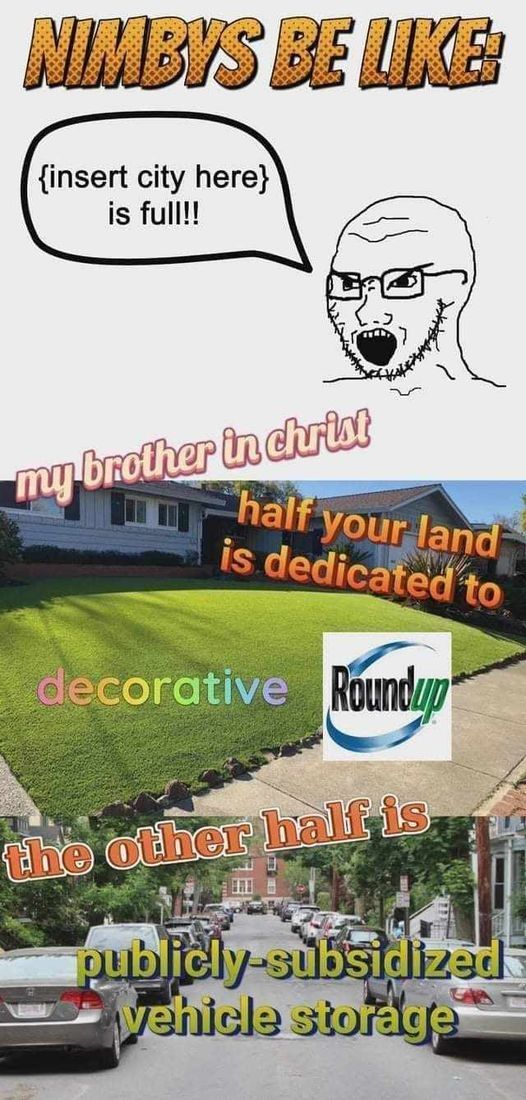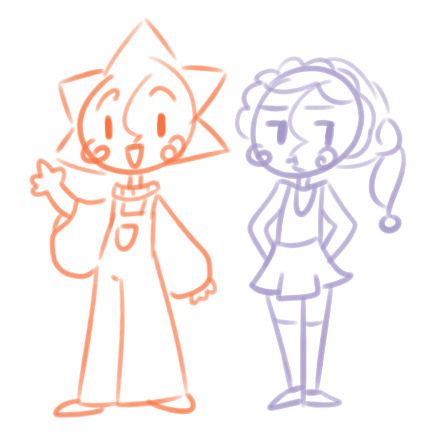#nimbis
Explore tagged Tumblr posts
Text

11K notes
·
View notes
Text
The housing emergency and the second Trump term

If you'd like an essay-formatted version of this post to read or share, here's a link to it on pluralistic.net, my surveill ance-free, ad-free, tracker-free blog:
https://pluralistic.net/2024/12/11/nimby-yimby-fimby/#home-team-advantage

Postmortems and blame for the 2024 elections are thick on the ground, but amidst all those theories and pointed fingers, one explanation looms large and credible: the American housing emergency. If the system can't put a roof over your head, that system needs to go.
American housing has been in crisis for decades, of course, but it keeps getting worse…and worse…and worse. Americans pay more for worse housing than at any time in their history. Homelessness is at a peak that is soul-crushing to witness and maddening to experience. We turned housing – a human necessity second only to air, food and water – into an asset governed almost entirely by market forces, and so created a crisis that has consumed the nation.
The Trump administration has no plan to deal with housing. Or rather, they do have plans, but strictly of the "bad ideas only" variety. Trump wants to deport 11m undocumented immigrants, and their families, including citizens and Green Card holders (otherwise, that would be "family separation" and that's cruel). Even if you are the kind of monster who can set aside the ghoulishness of solving your housing problems by throwing someone in a concentration camp at gunpoint and then deporting them to a country where they legitimately fear for their lives, this still doesn't solve the housing emergency, and will leave America several million homes short.
Their other solution? Deregulation and tax cuts. We've seen this movie before, and it's an R-rated horror flick. Financial deregulation created the speculative mortgage markets that led to the 2008 housing crisis, which created a seemingly permanent incapacity to build new homes in America, as skilled tradespeople retired or changed careers and housebuilding firms left the market. Handing giant tax cuts to the monopolists who gobbled up the remains of these bankrupt small companies minted a dozen new housing billionaires who preside over companies that make more money than ever by building fewer homes:
https://www.fastcompany.com/91198443/housing-market-wall-streets-big-housing-market-bet-has-created-12-new-billionaires
This isn't working. Homelessness is ballooning. The only answer Trump and his regime have for our homeless neighbors is to just make it a crime to be homeless, sweeping up homeless encampments and busting homeless people for "loitering" (that is, existing in space). There is no universe in which this reduces homelessness. People who lose their homes aren't going to dig holes, crawl inside, and pull the dirt down on top of themselves. If anything, sweeps and arrests will make homelessness worse, by destroying the possessions, medication and stability that homeless people need if they are to become housed.
Today, The American Prospect published an excellent package on the housing emergency, looking at its causes and the road-tested solutions that can work even when the federal government is doing everything it can to make the problem worse:
https://prospect.org/infrastructure/housing/2024-12-11-tackling-the-housing-crisis/
The Harris campaign ran on Biden's economic record, insisting that he had tamed inflation. It's true that the Biden admin took action against monopolists and greedflation, including criminal price-fixing companies like Realpage, which helps landlords coordinate illegal conspiracies to rig rents. Realpage sets the rents for the majority of homes in major metros, like Phoenix:
https://www.azag.gov/press-release/attorney-general-mayes-sues-realpage-and-residential-landlords-illegal-price-fixing
Of course, reducing inflation isn't the same as bringing prices down – it just means prices are going up more slowly. And sure, inflation is way down in many categories, but not in housing. In housing, inflation is accelerating:
https://www.latimes.com/opinion/story/2024-03-08/inflation-housing-shortage-economy-cpi-fed-interest-rate
The housing emergency makes everything else worse. Blue states are in danger of losing Congressional seats because people are leaving big cities: not because they want to, but because they literally can't afford to keep a roof over their heads. LGBTQ people fleeing fascist red state legislatures and their policies on trans and gay rights can't afford to move to the states where they will be allowed to simply live:
https://www.nytimes.com/2024/07/11/business/economy/lgbtq-moving-cost.html
So what are the roots of this problem, and what can we do about it? The housing emergency doesn't have a unitary cause, but among the most important factors is fuckery that led to the Great Financial Crisis and the fuckery that followed on from it, as Ryan Cooper writes:
https://prospect.org/infrastructure/housing/2024-12-11-housing-industry-never-recovered-great-recession/
The Glass-Steagall Act was a 1933 banking regulation created to prevent Great Depression-style market crashes. It was killed in 1999 by Bill Clinton, who declared, "the Glass–Steagall law is no longer appropriate." Nine years later, the global economy melted down in a Great Depression-style market crash fueled by reckless speculation of the sort that Glass-Steagall had prohibited.
The crash of 2008 took down all kinds of industries, but none were so hard-hit as home-building (after all, mortgages were the raw material of the financial bubble that popped in 2008). After 2008, construction of new housing fell by 90% for the next two years. This protracted nuclear winter in the housing market killed many associated industries. Skilled tradespeople retrained, or "left the job market" (a euphemism for becoming disabled, homeless, or destroyed). Waves of bankruptcies swept through the construction industry. The construction workforce didn't recover to pre-crisis levels for 16 years (and of course, by then, there was a huge backlog of unbuilt homes, and a larger population seeking housing).
Meanwhile, the collapse of every part of the housing supply chain – from raw materials to producers – set the stage for monopoly rollups, with the biggest firms gobbling up all these distressed smaller firms. Thanks to this massive consolidation, homebuilders were able to build fewer houses and extract higher profits by gouging on price. They doubled down on this monopoly price-gouging during the pandemic supply shocks, raising prices well above the pandemic shortage costs.
The housing market is monopolized in ways that will be familiar to anyone angry about consolidation in other markets – from eyeglasses to pharma to tech. One builder, HR Horton, is the largest player in 3 of the country's largest markets, and it has tripled its profits since 2005 while building half as many houses. Modern homebuilders don't build: they use their scale to get land at knock-down rates, slow-walk the planning process, and then farm out the work to actual construction firms at rates that barely keep the lights on:
https://www.thebignewsletter.com/p/its-the-land-stupid-how-the-homebuilder
Monopolists can increase profits by constraining supply. 60% of US markets are "highly concentrated" and the companies that dominate these markets are starving homebuilding in them to the tune of $106b/year:
https://papers.ssrn.com/sol3/papers.cfm?abstract_id=3303984
There are some obvious fixes to this, but they are either unlikely under Trump (antitrust action to break up builders based on their share in each market) or impossible to imagine (closing tax loopholes that benefit large building firms). Likewise, we could create a "homes guarantee" that would act as an "automatic stabilizer." That would mean that any time the economy slips into recession, this would trigger automatic funding to pay firms to build public housing, thus stimulating the economy and alleviating the housing supply crisis:
https://www.peoplespolicyproject.org/wp-content/uploads/2018/04/SocialHousing.pdf
The Homes Guarantee is further explained in a separate article in the package by Sulma Arias from People's Action, who describes how grassroots activists fighting redlining planted the seeds of a legal guarantee of a home:
https://prospect.org/infrastructure/housing/2024-12-11-why-we-need-homes-guarantee/
Arias describes the path to a right to a home as running through the mass provision of public housing – and what makes that so exciting is that public housing can be funded, administered and built by local or state governments, meaning this is a thing that can happen even in the face of a hostile or indifferent federal regime.
In Paul E Williams's story on FIMBY (finance in my back yard), the executive director of Center for Public Enterprise offers an inspirational story of how local governments can provide thousands of homes:
https://prospect.org/infrastructure/housing/2024-12-11-fimby-finance-in-my-backyard/
Williams recounts the events of 2021 in Montgomery County, Maryland, where a county agency stepped in to loan money to a property developer who had land, zoning approval and work crews to build a major new housing block, but couldn't find finance. Montgomery County's Housing Opportunities Commission made a short-term loan at market rates to the developer.
By 2023, the building was up and the loan had been repaid. All 268 units are occupied and a third are rented at rates tailored to low-income tenants. The HOC is the permanent owner of those homes. It worked so well that Montgomery's HOC is on track to build 3,000 more public homes this way:
https://www.nytimes.com/2023/08/25/business/affordable-housing-montgomery-county.html
Other – in red states! – have followed suit, with lookalike funds and projects in Atlanta and Chattanooga, with "dozens" more plans underway at state and local levels. The Massachusetts Momentum Fund is set to fund 40,000 homes.
https://www.nytimes.com/2023/08/25/business/affordable-housing-montgomery-county.html
The Center for Public Enterprise has a whole report on these "Government Sponsored Enterprises" and the role they can play in creating a supply of homes priced at a rate that working people can afford:
https://prospect.org/infrastructure/housing/2024-12-11-fimby-finance-in-my-backyard/
Of course, for a GSE to loan money to build a home, that home has to be possible. YIMBYs are right to point to restrictive zoning as a major impediment to building new homes, and Robert Cruickshank from California YIMBY has a piece breaking down the strategy for fixing zoning:
https://prospect.org/infrastructure/housing/2024-12-11-make-it-legal-to-build/
Cruickshank lays out NIMBY success stories in cities like Austin and Minneapolis adopting YIMBY-style zoning rules and seeing significant improvements in rental prices. These success stories are representative of a broader recognition – at least among Democratic politicians – that restrictive zoning is a major contributor to the housing emergency.
Repeating these successes in the rest of the country will take a long time, and in the meantime, American tenants are sitting ducks for predatory landlords, With criminal enterprises like Realpage enabling collusive price-fixing for housing and monopoly developers deliberately restricting supplies to keep prices up (a recent Blackrock investor communique gloated over the undersupply of housing as a source of profits for its massive portfolio of rental properties), tenants pay more and more of their paychecks for worse and worse accommodations. They can't wait for the housing emergency to be solved through zoning changes and public housing. They need relief now.
That's where tenants' unions come in, as Ruthy Gourevitch and Tara Raghuveer of the Tenant Union Federation writes in their piece on the tenants across the country who are coordinating rent strikes to protest obscene rent-hikes and dangerous living conditions:
https://prospect.org/infrastructure/housing/2024-12-11-look-for-the-tenant-union/
They describe a country where tenants work multiple jobs, send the majority of their take-home pay to their landlords – a quarter of tenants pay 70% of their wages in rent – and live in vermin-filled homes without heat or ventilation:
https://www.phenomenalworld.org/analysis/terms-of-investment/
Public money from Freddie Mae and Fannie Mac flood into the speculative market for multifamily homes, a largely unregulated, subsidized speculative bonanza that lets the wealthy make bets and the poor pay their losses.
In response, tenants unions are popping up all across the country, especially in red state cities like Bozeman, MT and Louisville, KY. They organize for "just cause" evictions that ban landlords from taking their homes away. They seek fair housing voucher distribution practices. They seek to close eviction loopholes like the LA wheeze that lets landlords kick you out following "renovations."
The National Tenant Policy Agenda demands "national rent caps, anti-eviction protections, habitability standards, and antitrust action," measures that would immediately and profoundly improve the lives of millions of American workers:
https://docs.google.com/document/d/1JF1-fTalW1tOBO0FhYDcVvEd1kQ2HIzkYFNRo6zmSsg/edit
They caution that it's not enough to merely increase housing supply. Without a strong countervailing force from organized tenants, new housing can be just another source of extraction and speculation for the rich. They say that the Federal Housing Finance Agency – regulator for Fannie and Freddie – could play an active role in ensuring that new housing addresses the needs of people, not corporations.
In the meantime, a tenants' union in KC successfully used a rent strike – where every tenant in a building refuses to pay rent – to get millions in overdue repairs. More strikes are planned across the country.
The American system is in crisis. A country that cannot house its people is a failure. As Rachael Dziaba writes in the final piece for the package, the situation is so bad that water has started to flow uphill: the cities with the most inward migration have the least job growth:
https://prospect.org/infrastructure/housing/2024-10-18-housing-blues/
It's not just housing, of course. Americans pay more for health care than anyone else in the rich world and get worse outcomes than anyone else in the rich world. Their monopoly grocers have spiked their food prices. The incoming administration has declared war on public education and seeks to relegate poor children to unsupervised schools where "education" can consist of filling in forms on a Chromebook and learning that the Earth is only 5,000 years old.
A system that can't shelter, feed, educate or care for its people is a failure. People in failed states will vote for anyone who promises to tear the system down. The decision to turn life's necessities over to unregulated, uncaring markets has produced a populace who are so desperate for change, they'll even vote for their own destruction.
#pluralistic#hysteresis#bubbles#bubblenomics#finance#nimby#yimby#restrictive zoning#localism#maslows hierarchy of needs#realpage#the rents too damned high#housing#weaponized shelter#rent strikes#tenants unions#the american prospect
257 notes
·
View notes
Text

i started reading this and honestly thought it was a shitpost bc i couldn't conceive of "yimby vs nimby" as anything other than what little green aliens say to each other
148 notes
·
View notes
Text
I love to see this kind of formatted research, nice work! Also, out of curiosity, do you happen to have a source which clarifies Nimbis being sinless/good souls? I know that the Tattle of Skellobits says that they are evil souls and that the one for Skellobombers says they're Nimbis who were evil and cast down, which could imply that souls and Nimbis are separate types of being. But if you have any information I missed that suggests that some Nimbis (not all, since they can be born) are souls that made it to the Overthere, I'd definitely be excited to see it!

Levels
Below we will analyze each of the worlds and some facts about 'em. Let's start!
Linealand Road

Lineland's Chapter 1-1 is a homage to the original Super Mario Bros. with its level design, which resembled the classic World 1-1 through its positioning of items, ? Blocks, and enemies like Goombas. The music is also remixed from the Super Mario Bros. overworld theme and the Super Mario World overworld theme.

Its skies are full of strange, surreal mathematical formulas, such as (translated into literary form) "Fire Flower is greater than or equal to some kind of Block divided by warp pipe". (As can be seen in the image)
Gloam Valley and Merlee's Mansion

The music of Merlee's Mansion has several interludes full of altered versions of Mimi's theme, however, the theme of Merlee herself is never heard throughout the entirety of Chapter 2.
The password 5963 can be read as 「ご苦労さま」 in Japanese, which means "You've been working very hard". Similarly, 41262816 can be read as「良い風呂に入る」, which means "Take a good bath"

The Bitlands

The Bitlands is a dimension located beyond Flipside Tower's yellow door in Super Paper Mario. It has a unique art style that makes the world look as if it was drawn on a grid, like pixel art. The overworld music in this world is an arrangement of the classic Ground Theme from Super Mario Bros. According to The InterNed, said overworld theme is titled "The Open Plane", while the music in the underground area beneath the two red pipes is titled "Nostalgic Underground", due to it being an arrangement of the Underground Theme from Super Mario Bros.
There is also a reference to the original Mario Bros in chapter 3-1

The Bitlands is also one of only two worlds where there is at least one boss in each section (Bowser in 3-1, who joins Mario's party after being defeated, Big Blooper in 3-2, Dimentio in 3-3, and Francis in 3-4), with Castle Bleck being the other world where this is the case.
Furthermore, including the optional Pixls, Barry and Tiptron, the player gets four Pixls in The Bitlands, which is more than in any other world in Super Paper Mario.
On the fortress that requires blowing up on a red X, there are some enemies that aren't normally attackable due to the fortress being too tall to jump on. These enemies don't require items to defeat though, as one can use Thoreau to grab the Bullet Bill Blaster's Bullet Bills and throw them back. One can also use Dashell, if obtained before Chapter 3, to jump off the fortress before it and use Princess Peach's Parasol to get on the fortress. This allows access to the other side of it that is normally otherwise inaccessible, and the ? Block that is normally destroyed with it can be hit (it gives a single coin).
This chapter is one of the ones with the most references, I will put all of these in a future part :)

Outer Space

Chapter 4 may not take place in the outer space above the , but rather that of another dimension. It was once the location of the kingdom.
If on the second visit to the level the player answers "no" to the prompt to use the space helmet, Tippi will personally attempt to convince them otherwise. After that, if the player says "yes" thrice, she will abandon the player in frustration, resulting in a Game Over. Upon further visits, the helmet is equipped automatically once they pass through the door. (If you want me to write all the absurd Game Overs, leave it to me in the comments)

Land of the Cragnons

It is the home of the Cragnons, a prehistoric race of primitive people with televisions and stereo CD players seemingly made of rocks. It is also home to the enemies of the Cragnons, the Floro Sapiens, who live underground with their king, who is the boss of Chapter 5.
The setting of this Chapter is similar to Chapter 5's in the original Paper Mario. In both Chapters, Mario must venture into a mountainous area (in Paper Mario, it was Mt. Lavalava, and here, it was the Gap of Crag), they both featured a comically-incompetent adventurer accompanying him during the Chapter (in Paper Mario, it was Kolorado, while in Super Paper Mario, it was Flint Cragley), and both had a plant boss (in Paper Mario, it was Lava Piranha, while in Super Paper Mario, it was King Croacus IV). Mario also gets a kind of hammer in both areas (in Paper Mario, it was an Ultra Hammer, while in Super Paper Mario, he gets a hammer-like Pixl named Cudge.)
Near the end of the game, during the final battle with Super Dimentio, the Land of the Cragnons is destroyed by The Void, but is restored following the destruction of the Chaos Heart along with all other demolished dimensions.

Sammer's Kingdom

It is destroyed by The Void in the main story, leaving nothing but an empty white space, but is restored after the story's end.
This land is ruled by King Sammer. It is most notable for being the location of the Duel of 100 tournament, in which challengers face off against 100 Sammer Guys. Only the first 25 Sammer Guys are faced in Chapter 6-1, while the rest are encountered in the three other chapters. However, in the main story, only the first 20 Sammer Guys are battled, and only 30 Sammer Guys are encountered.
In addition to the Duel of 100, Tippi and Tiptron's Tattles mention various other events held in the Sammer's Kingdom, such as the Sammer Guy Break Hour, the annual Sammer Guy BBQ, the Sammy Awards, and the annual Sammer Quiz; however, Mario and friends are unable to attend any of these in person.
The kingdom appears to be based on Japan, with "Sammer Guy" being a pun on "samurai".
According to Garson of the Flipside bar, The Underwhere, 1,500 years prior to the events of Super Paper Mario, the younger sister of Merlumina was entrusted with a Pure Heart, to give to the Sammer Kingdom's ruler to protect. Upon meeting however, Merlumina's sister and the Sammer King fell in love and she stayed behind. The two eventually married and had 100 children. Ever since, the number 100 has been sacred to the Sammer Kingdom.
After finishing the game, the gang may start the Duel of 100 over. As before, Chapter 6-1 has Rounds 1-25. After defeating Sunshine Flood, Mario and co. will be able to continue on to 6-2.
If the player returns to Sammer's Kingdom after finishing the Duel of 100, King Sammer will be found on Gate 1. He will say the Age of the Sammer Guys ended and that he sent the Sammer Guys on a tropical vacation. He also jokes that he will replace them with kitty robots. When Tiptron uses Tattle on him, she reveals he is planning to turn the Duel of 100 Battle Gates into a water amusement park.
During the battle, as the players advance to the next sub-chapter, the number of flags seen on the stage will increase by one (i.e. one flag on every stage of Chapter 6-1, two in Chapter 6-2, and so on).
When the player tries to go to Gate 2 after completing the Duel of 100, they will discover that the door leading there cannot be used, as if it has become part of the background. When Tattle is used on the door, Tiptron will say the door is sealed, which might be because the other Gates disappeared, and they are currently working on the water amusement park there. Oddly, when the player uses Tattle on the very same door while in 3-D, Tiptron will say the player can open it by pressing , the same as her Tattle of any door.

The Underwhere

It is also called World -1 by one of the residents, a reference to the famous "Minus World" glitch from the original Super Mario Bros. Ruled by Queen Jaydes, The Underwhere makes up one half of the "afterlife" dimensions, and is where people who have been neither good nor bad from "all worlds" go when they die. Once there, the people become ghost-like creatures known as Shaydes (a corruption of the word "Shades").
The Underwhere can be compared to the Asphodel Meadows of the ancient Greek underworld, hence its name, which is a humorous play on the words "underworld" and "underwear". Queen Jaydes herself was named for the Greek god of the underworld, Hades, and there are numerous other aspects of The Underwhere taken from Greek mythology (listed below). However, the Underwhere's counterpart, The Overthere, where the sinless can spend eternity as angelic Nimbis, is more heavily based on Heaven than the Greek Elysian Fields. Bonechill's prison, the place where people go when they have been very bad in life, is equivalent to Tartarus, also from Greek mythology, although the fact that he was a fallen Nimbi and his association with ice does bear resemblance to the story of Lucifer, who, according to Dante's Inferno, is trapped in ice in the deepest circle of Hell.
In The Underwhere and its counterpart, The Overthere, many characters or places that are encountered are references to other things, in most cases the names are specifically based off of Greek Mythology.
Shayde, a corruption of Shade
Jaydes, a corruption of Hades
The Underwhere itself, a corruption of The Underworld
The River Twygz (twigs), a corruption of the River Styx
D-Man
Charold, the man who runs the ferry across the River Twygz, is a corruption of Charon
Underchomp, a reference to Cerberus (both act as three-headed dogs who guard the gates to the underworld
The three hags reference the three Moirai, or the Fates, in Greek mythology.
The Underwhere and The Overthere are comparable to Flipside and Flopside
A "beveragarium" that serves milk beneath Flipside is named "The Underwhere"; another one in Flopside is named "The Overthere."
This is the only chapter where none of Count Bleck's minions are fought.

(A/N): As you can see, I am missing chapter 8, because I have already exceeded the limit of images, but I will take a separate part of it because I think its story is worth it. I hope you liked it!
13 notes
·
View notes
Note
on the plus side cambridge abolished zoning limits lmao
definitely the funniest part about Cambridge are the people who live there and have never been to Europe claiming that Cambridge is basically Amsterdam because they have bike lanes. like okay get back to me when you have housing units over 2 stories and a squatting movement and legal weed on every street corner
35 notes
·
View notes
Text

La prototipa 😁 piddina,basta toccarli sul loro
57 notes
·
View notes
Text
Is it just an inevitability that rent will go up regardless of the labor supply in an area?
Because during the pandemic, immigration went way down and even kinda reversed as people returned to their countries of origin, so the labor supply shrank, pay rose, and so landlords spiked rents because they could because people had money that could be squeezed.
If immigration increases, demand for housing increases faster than construction, and rents increase.
What situation would cause rent to decrease? Is “major local employer massively reduces labor force/local labor demand craters” the only thing that would ever lead to rents going down in an area?
#the rent is too damn high#labor shortage#nimby#immigration#original post#it’s the economy stupid#landlord
26 notes
·
View notes
Text
#tiktok#utah#Kaysville#warming center#warming station#homelessness#houseless#houselessness#nimby#nimbyism
42 notes
·
View notes
Text

Messier 44 / Beehive Cluster aka Praesepe
Praesepe is one of the nearest start clusters, containing over 1000 stars, to earth found in the constellation of Cancer.
#My main in wow is named nimby#i want to move to mooongaurd and the name is taken#thinking about changing it to the name Praesepe#astrology#constellations#cancer star#zodiac#astronomy
29 notes
·
View notes
Text







doodles old to new @bangbang-adri with her love eclipse, 2 dca ocs named Molly and Nimby i made for an rp <3, smoon loaves and doodles from today (so far) ft @crazedauthor givin the boys a smooch and receiving a pat
32 notes
·
View notes
Text
Step 1: Go to ao3
Step 2: Search Dimentio/Reader fics
Step 3: Sigh and leave when no new ones have been posted.
Repeat daily
#EVERYDAY#I CRY#dimentio#:[#baby boooy#nobody hardly writes a reader insert with you#when i do see a new fic i GOTTA leave a comment and kiss the author on the mouth. then reread said fic a million times lmao#even if it's one that's not finished i reread the SHIT outta it#for those that have made dimentio x reader content. i love you#there's one(s) where the reader is a little Overthere nimbi creature and it's so unique. i love that one lots#i like rereading the older dimentio x reader fics as one way to hype myself up for writing#i have read every dimentio x reader out there on the web. the ones on wattpad. ao3. quotev. tumblr- alla thems#yes this is a cry for help#if you make a dimentio x reader fic i will start doing the worm and then explode
41 notes
·
View notes
Text
Blatantly Partisan Party Review I (WA 2025): Sustainable Australia Party–Anti-corruption
Prior reviews: federal 2013, federal 2016, VIC 2018, NSW 2019, federal 2019, federal 2022, VIC 2022, NSW 2023, plus my friend’s b_auspol review for WA 2021
What I said before: “I am aware of some well-meaning people in this party with centrist or centre-left environmental views, but the overall thrust is NIMBY and anti-immigration and I cannot in good faith offer any endorsement.” (NSW 2023)
What I think this year: Sustainable Australia (SusAus) is the party that has never had a name it didn’t want to change. Starting life as the Stable Population Party, they are registered in WA as “Sustainable Australia Party—Anti-corruption”, while at federal level they changed from “Sustainable Australia Party—Stop Overdevelopment/Corruption” to “Sustainable Australia Party—Universal Basic Income” in November 2023. If they could simply stop tacking slogans or policy principles onto their name, that would be grand.
Anyway, these geniuses who can’t settle on a name have reached quite possibly the dumbest solution to the housing crisis: instead of responding to the current demand for housing in Australia by increasing the supply of housing, they want to reduce supply and somehow make demand disappear. This is fantasyland nonsense. Demand outstripping supply cannot be waved away. There is legitimate debate on how to best increase supply and the extent to which the state or the private sector should provide housing. But SusAus are not here for any of that.
Instead, SusAus are here to push their barrow about “stabilising” the population. What this means is reducing immigration to Australia and promoting measures to reduce population growth in other countries. This sort of talk very quickly leads to racist ideas about certain peoples “breeding like rabbits” and towards eugenicist policies to limit who can reproduce and when. Comically, SusAus now have a statement on their website that “SAP is a pro-immigration party”. This is “my shirt is raising a lot of questions already answered by my shirt” territory and recalls for me how Health Australia kept insisting they were not an anti-vax party while peddling anti-vax policies. If you want fewer people to come to a country, you quite objectively are not pro-immigration. SusAus are anti-immigration and they are population nihilists who would prefer it if you simply had not been born because you made the population go up.
Despite this, SusAus goes on about how they support “a science and evidence-based approach to policy”. There’s a good point in the b_auspol review from 2021 that “when people start waving that around as a banner cry, there does tend to be rather an overtone of ‘if you don’t agree with us then obviously you are being illogical and emotional’.” SusAus continues that they do “not [have] a left or right wing ideology”, and almost anyone who ever says that is either too cowardly or too wishy-washy to state their actual position on the political spectrum, and they usually turn out to be on the right.
To be honest, I am not terribly interested in engaging with the rest of their policies because their core principles are discrediting. If you are an urbanist or a YIMBY, this is not the party for you and never will be. I’m an urbanist and I’m at least YIMBY-adjacent; I like compact and dense cities for their accessibility and cultural vibrancy and agglomeration effects that make things like public transport, education, and healthcare more efficient to provide. (I am wary of some of the more fervent anti-regulation strands of YIMBYism, conscious as I am of the dire living conditions of unregulated housing for poorer communities in the past.)
SusAus have at least expanded their rhetoric to criticise housing sprawl but they continue to go on about “inappropriate high-rises” and lord knows what that is: a high-rise that dresses immodestly? An apartment that says slurs? No housing is “inappropriate” if it puts a roof over somebody’s head and allows them to lead a happy, healthy life as part of the community. Sorry folks but nobody will like the appearance of every building. For a party that bleats about evidence-based policy, SusAus's attitude towards denser cities seems to boil down to “I don’t like change and that new block of apartments down the road doesn’t meet my own particular aesthetic values”.
If you want to really talk about sustainability, you talk about densifying cities and reducing sprawl. You talk about replacing old housing stock that is no longer fit for purpose so that people who currently live in draughty, mouldy old houses can move into well-insulated, energy-efficient modern housing. You talk about giving people more options about where to live and how they live. You sure as shit don’t talk about restricting housing, retaining unsustainable and inefficient urban forms, enforcing your aesthetic preferences, or embracing “fuck off we’re full” attitudes.
So, to conclude, what I say to people who want to reduce Australia’s population is this: you first.
Recommendation: Give Sustainable Australia Party–Anti-corruption a weak or no preference.
Website: https://www.sustainableaustralia.org.au/2025_wa_election
#auspol#ausvotes#WApol#WAvotes#Western Australia#WA#Election 2025#Sustainable Australia Party#Sustainable Australia#SusAus#WA election#NIMBYs#weak or no preference
11 notes
·
View notes
Text
I would like you all to meet my new son. His name is Nimbus.

8 notes
·
View notes
Text




“mondays five pm” (2025) // acrylic on canvas
my town is full of unwelcoming signs and it makes me feel better to paint them .
available here.
#my artwork#acrylic#no trespassing#office building#liminal#asheville nc is a big NIMBY town#this is in regard to homelessness
10 notes
·
View notes
Text
Libertarians should campaign against HOAs instead of age of consent laws and the usps
#The idea of letting other mfs decide what you can and can’t do with your own property seems so antithetical to American culture to me#it kinda boggles my mind HOAs exist. But I guess NIMBY culture is also very American
10 notes
·
View notes
